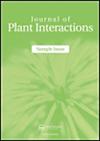iTRAQ-based proteomic analysis of rice seedlings’ resistance induced by Streptomyces JD211 against Magnaporthe oryzae
IF 3.3
3区 生物学
Q2 PLANT SCIENCES
引用次数: 0
Abstract
ABSTRACT Streptomyces JD211 induces rice resistance and reduces the disease index of rice blast. However, the key pathways or components involved in the defense mechanism by which antagonistic microorganisms cause resistance have not been elucidated. To better understand the cellular process involved in JD211-induced resistance, the changes of proteomics in the rice treated with JD211 and Magnaporthe oryzae were investigated. Most proteins associated with porphyrin and chlorophyll biosynthesis decreased in M. oryzae-infected rice, whereas these proteins increased in the rice treated with JD211. Proteins increased by JD211 were also involved in the phenylpropanoid pathway, signal transduction, and ascorbate biosynthesis. These results indicated that JD211 could protect rice from M. oryzae damages by promoting signal transduction and inducing the production of phenylpropanoids. JD211 contributed to energy synthesis for defense responses in plants, reduced the damage of M. oryzae, and improved the rice resistance by inducing an array of defense responses more quickly and efficiently in the rice. The obtained data provide not only important information for understanding the molecular mechanism involved in JD211-induced resistance but also application clues for genetic breeding of crops with the improved M. oryzae resistance.基于iTRAQ的JD211链霉菌诱导水稻幼苗对稻瘟病菌抗性的蛋白质组学分析
链霉菌JD211诱导水稻抗稻瘟病,降低稻瘟病的发病指数。然而,拮抗微生物引起耐药性的防御机制中涉及的关键途径或成分尚未阐明。为了更好地了解JD211诱导抗性的细胞过程,研究了JD211和稻瘟病菌处理水稻的蛋白质组学变化。大多数与卟啉和叶绿素生物合成相关的蛋白质在米曲霉感染的水稻中减少,而这些蛋白质在用JD211处理的水稻中增加。JD211增加的蛋白质也参与苯丙烷途径、信号转导和抗坏血酸生物合成。这些结果表明,JD211可以通过促进信号转导和诱导苯丙烷类物质的产生来保护水稻免受米曲霉的损伤。JD211有助于植物防御反应的能量合成,减少米曲霉的危害,并通过在水稻中更快、更有效地诱导一系列防御反应来提高水稻的抗性。所获得的数据不仅为了解JD211诱导抗性的分子机制提供了重要信息,而且为提高米曲霉抗性作物的遗传育种提供了应用线索。
本文章由计算机程序翻译,如有差异,请以英文原文为准。
求助全文
约1分钟内获得全文
求助全文
来源期刊

Journal of Plant Interactions
PLANT SCIENCES-
CiteScore
5.30
自引率
6.20%
发文量
69
审稿时长
>12 weeks
期刊介绍:
Journal of Plant Interactions aims to represent a common platform for those scientists interested in publishing and reading research articles in the field of plant interactions and will cover most plant interactions with the surrounding environment.
 求助内容:
求助内容: 应助结果提醒方式:
应助结果提醒方式:


